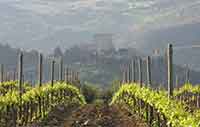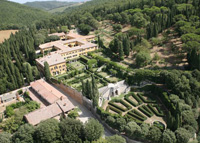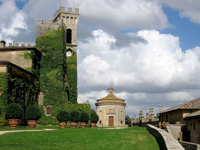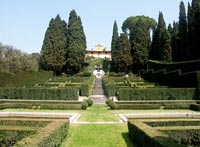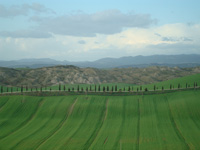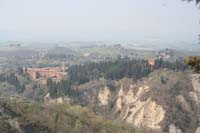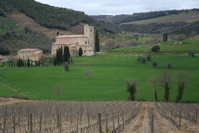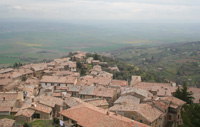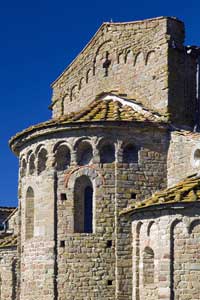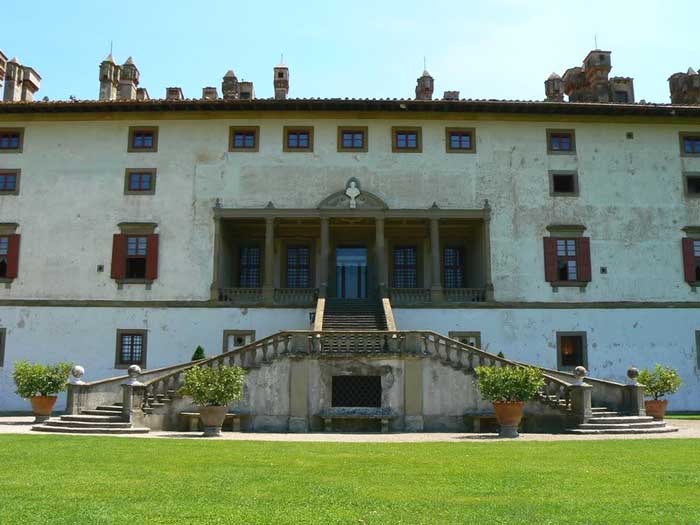 |
| Villa Medicea la Ferdinanda |
Villa Medicea La Ferdinanda |
Villa Artimino also known as Villa La Ferdinanda is one of the most beautiful Medici Villas in Florence surrounding area. The villa belonging to the extensive Artimino Resort is an extraordinary setting and the view from the back terrace/lawn over the Tuscan hills covered with vineyards and olive groves is absolutely magnificent.
|
The first terrace, immediately behind the villa, is a broad grassy area stretching the length of the northern side of the building, on which an ancient wisteria hangs. To the east, on the same level, is the entrance to a delightful secret garden, rectangular in layout and edged in box hedges. Access to this formal garden, separated from the lawn by another box hedge, is marked by two columns surmounted by two terracotta griffins. |
||
| Grand Duke Ferdinando I de’ Medici commissioned the impressive villa from Bernardo Buontalenti. It became known also with the name of "La Ferdinanda" or "Villa of the One Hundred Chimneys" for the picturesque series of chimneys of various shapes that rise from its roof. Intended as a hunting lodge, the villa often hosted the grand-ducal court. Inside, the hall called "of the villas" housed the seventeen lunettes (today conserved in the Museum of "Florence as it was") depicting the Medici residences that Flemish artist Giusto Utens painted in the late 16th century. It was then that the villa with its iconographic collection became the ideal centre of the Medici possessions in the Florentine countryside. The villa too, is a Galilean site: from June 24 to August 23, 1608, the court was staying at Artimino, and Grand Duke Ferdinando I de’ Medici invited Galileo Galilei to come in August to instruct his son (the future Grand Duke Cosimo II) in mathematics. The villa was also theatre of many experiments by the Accademia del Cimento. In September 1657, numerous endeavours were made to measure atmospheric humidity under different meteorological conditions, utilising the condensation hygrometer. Moreover, the academicians performed barometric experiments in the surrounding countryside in order to verify the variation of atmospheric pressure with changes of altitude. Since 1983, the basement of the villa has hosted the Municipal Archaeological Museum of Artimino, which conserves finds, mainly from the Etruscan age, of the territory of Carmignano. |
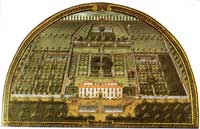 Lunette by Giusto Utens of Villa medicea di Castello, Florence (1598) Lunette by Giusto Utens of Villa medicea di Castello, Florence (1598) 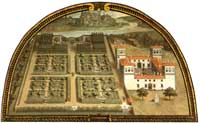 Lunette by Giusto Utens of Villa Ambrogiana (1598) |
|
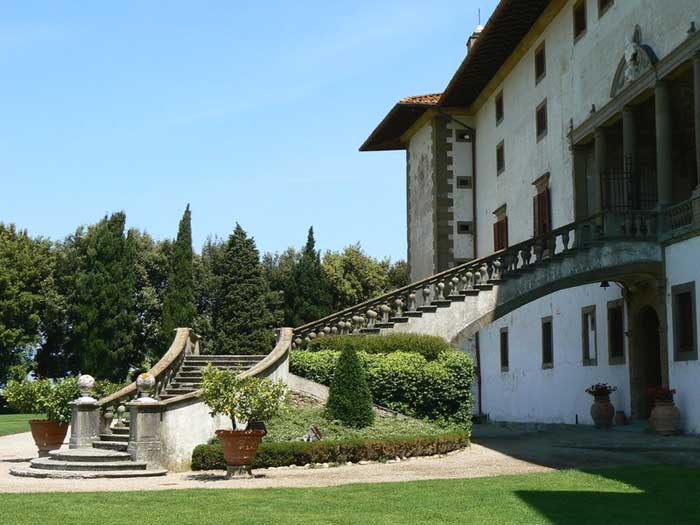 |
||
Address: Carmignano, Artimino, Via Papa Giovanni XXIII 5 |
||||
Artist and writer's residency | Podere Santa Pia |
||||
Podere Santa Pia and famous wines |
Podere Santa Pia |
La Foce garden |
||
Villa Celsa |
Villa I Tatti, near Settignano, outside Florence |
Val d'Orcia |
||
Monte Oliveto Maggiore abbey |
Abbey of Sant 'Antimo |
Montalcino |
||
| Carmignano is a typical village of the Tuscan countryside, located about 20 km west of Florence and about 10 km southwest of Prato.
|
||||
| The church of San Francesco stands at the place where Saint Francis of Assisi was granted land by the commune of Carmignano in 1211 and a monastery was erected. On the site, in 1330, the parish church of San Michele was built in honor of the town’s patron saint. The church contains Pontormo’s undisputed masterpiece of the Visitation (1530), one of few works left by the eccentric artist whose real name was Jacopo Carrucci. Also to be viewed there a Madonna with child and saints by Cosimo Lotti and the 17th century altar pieces by Giovan Pietro Naldini. The remains of la Rocca, the medieval fortress overlooking the town, are now marked by a bell tower with a clock. Constructed between 1125 am 1138 and reinforced in succeeding eras, the strategically situated fortress was frequently fought over by rulers of Florence, Prato and Pistoia. When captured by Castruccio Castracani degli Alteminelli in 1325, instead of destroying it, as had been the practice of the ruthless war lord with previous conquests, he reinforced it, realizing the importance of its position with views over the vast plain between the Montalbano range and Florence. The Medici villas of Carmignano and Poggio a Caiano are considered masterpieces of Renaissance architecture. Several lie within the Barco Reale, epitomized by the Villa Ferdinanda at Artimino, also known as the Villa dei Cento Camini for the hundred chimneys protruding from its roof. Carmignano is noted for its Romanesque churches and chapels dating to the Middle Ages. Five of special note in the commune are San Giusto al Pinone, San Jacopo a Capezzana, San Leonardo ad Artimino, San Lorenzo a Montalbiolo (with a panel by the Florentine painter Giovanni Bizzelli), and San Martino in Campo. The Etruscans The Etruscans who settled in the Artimino area as early as the seventh century B.C., used the Arno River for their flourishing trade Tuscany and beyond. They built an acropolis and what later became the site of villa of the hundred chimneys at Artimino, where remains of tombs have also been found. Other necropolises have been located at Montefortini, Prato di Rosello and Comeana, while traces of a settlement have been discovered at Pietramarina. Etruscan relics are collected in the Museo Comunale Archeologico at Artimino. Artisan crafts Stone carving has been a specialty of Carmignano since Etruscan times, when pietra serena for cutting and sculpting was extracted from caves along the right bank of the Arno river. In the Middle Ages, stone was quarried along the Ombrone stream at the village of Comeana where stonecutters known as Scalpellini della Gonfolina were renowned for their work. Hand cut stone, often of masterful realization, adorns villas, churches, palaces, fountains, gates and even simple country homes of the area. The craft continues today among scalpellini, assisted by machinery that makes their work easier and safer though none the less artistic. Modern art Il Parco Museo Quinto Martini at Seano displays a collection of 36 sculptures in bronze created by the artist Quinto Martini between 1931 and 1988. The works are distributed through a park believed to constitute one of the largest displays by a single artist anywhere. Martini, a native of Seano who died in 1990, was well known in Europe for his work. On permanent display in Carmignano’s town hall are the pastels of another local artist, Aldo Cigheri, who died in 1995 at the age of 86 after decades of depicting colorful scenes throughout Italy. |
||||
Wikimedia Commons contiene file multimediali su Pieve di Santa Maria e di San Leonardo. |
||||

